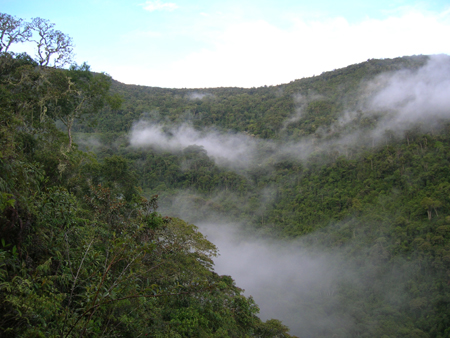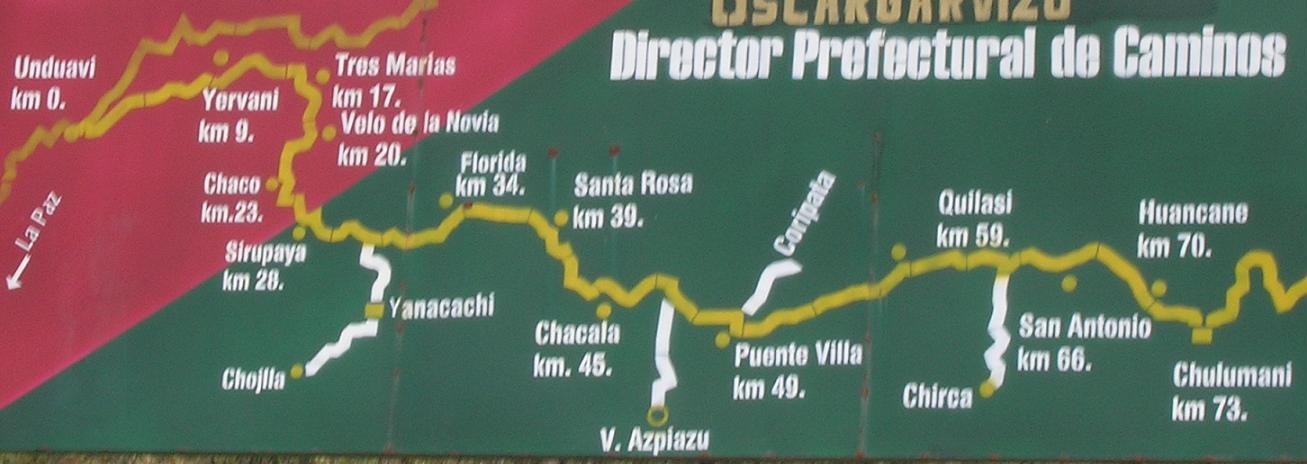Apa Apa Reserve
by Lawrence
Rubey and A. Bennett Hennessey
 Update: I was told in January 2022 that the Apa Apa forest remains, but some of the larger trees have been cut down, the edges are closer with agricultural fields, and the road that runs through the forest reserve has much more frequent traffic now- so not as silent as in the past. But I was told the forst still has a lot of the great birds of the past. Accomodations is difficult now, especially after COVID. Update: I was told in January 2022 that the Apa Apa forest remains, but some of the larger trees have been cut down, the edges are closer with agricultural fields, and the road that runs through the forest reserve has much more frequent traffic now- so not as silent as in the past. But I was told the forst still has a lot of the great birds of the past. Accomodations is difficult now, especially after COVID.
Apa-Apa Ecological Reserve, part of the
Portugal families Apa-apa Hotel, located just north of the town of Chulumani,
is one of the best "accessible" sites in Bolivia for middle-montane Yungas species. Although access is a bit difficult, this is a premier site that
offers a host of interesting species. This is the only site in
Bolivia
where
the Scimitar-winged Piha has been commonly seen. Other key species for this
site include Hooded Tinamou, Rufous-faced Antpitta, Short-tailed Antthrush,
Scarlet-breasted Fruiteater, Chestnut-crested Cotinga (scan the tops of the
forest in open areas), Straw-backed Tanager, Versicolored Barbet, Yungas
Manakin, and Slaty Finch. Joseph Tobias has reported Oilbirds drinking from a
small pond on the summit. "Arriving from the Chulumani side, a small
half-hidden path runs off to the right at the very summit of the road. This
path passes an obvious pond after 40 m  or
so. The Oilbirds come to drink or bathe at the pool from just after dark."
This suggests that there is an Oilbird cave nearby which is probably active
from September to March. or
so. The Oilbirds come to drink or bathe at the pool from just after dark."
This suggests that there is an Oilbird cave nearby which is probably active
from September to March.
Unlike much of the
La Paz Yungas, where
accessible forests are dominated by second-growth and logging has wiped out
many of the larger trees, Apa-Apa is mostly a virgin forest. That it survives
to this day is largely a tribute to the
Portugal
family and strict
community prohibitions on logging and land clearing in the forest. The forest
was once part of a large coca estate that was broken up in the land reforms
following the 1952 revolution. The Portugal's, whose ownership of the estate
dates to the 1600s, still live in the valley below the forest and are working
to promote sustainable eco-tourism in the forest. They also run the Apa-apa
Hotel, which can receive guests from Chulumani.
Apa-Apa
can be approached from the trails from the Apa-apa hotel, about an hours walk
from the hotel, or along the main road. Most birding is done from either the
road that runs from
San Cristobal, through the
forest, to the
village
of
San Isidro on the
other side of the serrania or from the Portugal Hacienda winding up
into the forest. Fortunately, the
San Isidro road sees little traffic (one or
two vehicles per day), while the Hacienda road eventually becomes a
narrow track suitable only for foot traffic. From either
San Cristobal or Hotel Apa apa, the real
forest begins at about
2,150
meters after passing through second-growth forest and
recently burned areas. Foraging flocks can be encountered anywhere from here.
From
2150 meters,
both roads climb to intersect the summit at about
2450 meters. Listen
for Rufous-banded Owl here at night. The other side of the summit is
significantly drier and the road descends into the
village of
San Isidro.
Nearly 150 species have been recorded in Apa Apa and this number is likely to
grow as more research is conducted. a
narrow track suitable only for foot traffic. From either
San Cristobal or Hotel Apa apa, the real
forest begins at about
2,150
meters after passing through second-growth forest and
recently burned areas. Foraging flocks can be encountered anywhere from here.
From
2150 meters,
both roads climb to intersect the summit at about
2450 meters. Listen
for Rufous-banded Owl here at night. The other side of the summit is
significantly drier and the road descends into the
village of
San Isidro.
Nearly 150 species have been recorded in Apa Apa and this number is likely to
grow as more research is conducted.
Logistics: Chulumani, a pleasant village in the Yungas, is on the
South Yungas Road
(note this is one of those steep edged Andean roads that requires an experienced
driver), less than four hours from
La Paz
(Chulumani is only
115
kilometers from
La Paz,
but such distances are deceptive given the quality of the road). Contact information has changed. The best way
to visit Apa-Apa ecological reserve is to contact Ramiro Portugal at 725 47770 (you can try to make a reservation at
apapayungas@hotmail.com). The Apa-apa hotel is nestled
in a valley below
Apa-Apa
Forest and offers
hiking trails into the forest. Accommodation is available at the Apa apa
hotel (five rooms with private bathrooms- max. occupation 16 people- plus
camping). Prices in 2008 for the hotel is around 8 US$ per person, lunch and diner
is around 2 US$. One can make a reservation at the Apa-apa hotel from
La Paz,
and then take a local bus to Chulumani (see a
Bolivia
guide for bus info) and
phone the Apa-apa office in Chulumani.where
they can pick you up in their vehicle. There is also a one time obligate 25
US$ fee for a guide tour of the forest trails.
The
Portugals
own the Apa-apa ecological reserve. If you wish to enter the area for the day
on the road or stay at a different hotel, we strongly suggest you contact the
reserve with the contact information mentioned above to request entrance
permission and the day fee. If you stay at hotel Tamapaya, you should make
arrangements with the owner to leave a entrance fee donation for the Apa-apa
lodge.
If
you have a larger group, or need a hotel closer to
La Paz,
an excellent option is to back-track to
21.2 km to Puente Villa
(the main bridge). Just after the Puente Villa bridge (remember you are
back-tracking travelling from Chulumani to
La Paz)
is the Hotel Tamapaya. Coming down from
La Paz,
before you reach the Unduavi river and the Puente Villa bridge, there is a
turn off to the left with the sign Hotel Tamapaya. The grounds offer good
birding and a double room is less than $30. Recently the
La Paz
office has been closed, but reservations for Hotel Tamampaya and Hotel Apa
apa can be made throughbirdbolivia@birdbolivia.com.

For those intent on visiting with your own vehicle
re-set your odometer at zero at the start of the
South
Yungas road (Unduavi). At ~49 km you will pass Puente Villa, close to
Tamampaya Hotel. At
69.5 km
on the South Yungas road arrive at the
village of
San Cristobal.
The road actually enters the main
plaza
of
San Cristobal (
1900 meters
elevation). At the plaza re-set odometer again to zero (0.0). Instead of
bearing right and continuing to Chulumani, bear left around the plaza, and
make a sharp right turn at the street corner dominated by the pink church.
Following the street uphill (can be rough going!), the road forks in three
directions after
100
meters or so. Take the central fork, keeping the
houses on your immediate right. Continue climbing, passing modest farmers'
houses and cross a soccer field. At
5.8 km on this access road, the forest
begins. A wider part of the road can be found at about
7 km where it is possible to
park or even camp. The summit (
2450 meters) is reached at
8.7 km from
San Cristobal
Plaza. If you plan on using public
transportation and hike in, get the bus to Chulumani and ask to be let off
the bus at San Cristobal (but notify Apa-apa ecological reserve before hand).
GPS reading at point on access road where forest begins:
S 16 20.971' W 67 30.569'
Bird
List |

